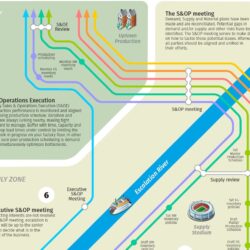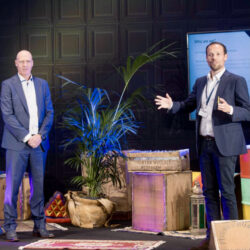Pandemic accelerates implementation of IBP

Following on from S&OP, many companies are working on the next step: the implementation of integrated business planning (IBP). What is the impact of COVID-19 on this step? Experts from McKinsey and Blue Yonder discussed this during the recent Webinar Wednesday. Tool manufacturer Hilti faces the step to IBP with confidence: “The involvement of general and financial management has never been as great as during this crisis.”
By Marcel te Lindert
When the pandemic broke out, Hilti had just completed the first phase of implementing sales & operations planning (S&OP). In the space of two years, the manufacturer of system solutions for construction professionals had established a well-functioning monthly process that resulted in a single integrated sales and production plan. “It is a global, cross-functional process with central teams for planning and forecasting. Every month, we consult with our factories to coordinate the production capacity of all 180 production lines, among other things,” said Federico Scotti di Uccio, Head of Markets Materials Management & Sales Planning at Hilti.
The results were positive. In 2019, forecast reliability improved compared with 2018, with the forecast accuracy gaining five percentage points measured on a global level over a four-month offset period. In fact, the forecast bias (the general tendency for a statistical forecast to be too high or too low) was reduced to zero in both years. “As a result, the supply chain reliability has increased significantly,” explained Scotti di Uccio. “Product availability is up by several percent, while the number of back orders has decreased. Crucially, we have reduced the variability in the production planning by as much as 20-25% on some production lines. Less variability means more stability. This not only leads to fewer buffers and more efficient inventories, but also to maximum capacity utilization.”
Weekly S&OP cycle
Like virtually every company, Hilti’s forecasting performance deteriorated sharply when the COVID-19 pandemic broke out in early 2020; forecast bias shot up, while reliability dropped sharply. Despite all the challenges, the S&OP process carried Hilti through the crisis, said Scotti di Uccio. “When the virus spread in China, the first thing that happened was a crisis in the supply from the Far East. To avoid shortages, we had to speed up the supply chain, so we assessed and managed out-of-stock risks and built up additional stocks where it made sense. It was crucial to have central communication, visibility and control through our central planning teams and within the framework of S&OP.”
This was followed by a crisis in market demand. Within a week, daily sales dropped by 80-90%. “We quickly introduced new scenarios, scaled down production and adjusted forecasts. At the same time, we turned the monthly S&OP process into a weekly process to create additional agility for that period and to gain a better sense of market demand. From the summer onwards, we entered the recovery phase, in which we no longer needed the extra agility and went back to a monthly process in almost all markets,” continued Scotti di Uccio. “By the end of the year, both forecast bias and forecast reliability were almost back to pre-pandemic levels. The performance regarding product availability and stock levels was also relatively good. We continue to closely monitor the demand and the supply chain and we have many risk measures still in place. However, our supply chain has shown the necessary resilience, partly thanks to the S&OP process.”
Integrated planning
McKinsey places Hilti in the category of companies that know what risks to expect and are able to respond quickly. But this is by no means the case for all companies. “We speak to many companies that use Excel as a planning tool and therefore do not have an integrated planning system, which reduces transparency to a minimum. Every morning you have to wait and see what is going to happen. This applies in particular to suppliers. Many companies are aware of their first-tier suppliers and exchange data with them, but that is not the case for second or third-tier suppliers. We are only now seeing systems and processes emerging that can facilitate this,” stated Knut Alicke, a partner at McKinsey.
Alicke advocated the integration of visibility and planning tools, and illustrated this with the example of the Suez Canal blockade: “It’s not enough to know that your container is stuck there. You need alternatives. That requires integration with end-to-end planning systems and scenario planning. Speed is also important, which requires faster S&OP processes. A 100%-perfect decision is not necessary in crisis situations; a decision that is 80% correct is sufficient. And then it’s important to implement that decision quickly.”
Looking ahead
Software vendor Blue Yonder – which also supplies to Hilti – agreed with McKinsey, having seen companies without an integrated planning system struggle. “They had to rely on Excel and other systems without advanced modelling tools to calculate scenarios and respond adequately to developments,” said Alan Duncan, Industry Strategy Lead Manufacturing at Blue Yonder.
Duncan’s colleague Gabriel Werner advised them to start implementing software that answers a seemingly simple question: What is going on in my supply chain right now? “That question appears to be straightforward, but it is difficult to answer for many companies. What helps is a cloud platform that enables petabytes of data to be processed quickly. That makes it possible to monitor the supply chain in real time. And perhaps most interesting is the ability to look ahead. The current way of planning is deterministic. But what if we can supplement our plans with predictions about the future state of the supply chain?”
Werner mentioned the use of machine learning for demand planning as one example, and there are also opportunities in the area of supply planning: “In recent years, we have invested in shorter planning cycles. But does that mean we know sooner what is going to happen? No, we can only react to it faster. With machine learning, we can see disruptions coming before they happen, so that we can really take proactively action.”
Step to IBP
Now that the situation has somewhat stabilized, Hilti is preparing for the next step: advanced S&OP, i.e. IBP. Scotti di Uccio referred to the stages of maturity as defined by Gartner: “We are now between the third and fourth level. We hope to reach that fourth level in 2023. Among other things, that means that we want to extend our S&OP to our key allied suppliers and broaden the focus horizon from six months to 18 months. In addition, we want to better integrate market intelligence, leverage CRM, improve demand sensing and further link it to our financial planning. We want to make more use of new technologies such as machine learning and predictive analytics, so that we can act on future disruptions proactively rather than reactively.”
The experiences during the pandemic will certainly help in the implementation of IBP. Scotti di Uccio: “The crisis has shown how important it is to have an agile, resilient supply chain. Within Hilti, we have started to work together more closely than before. The involvement of our general and financial management in the S&OP process has never been greater. They have seen that S&OP is a crucial business process that contributes to the realization of the strategy.” Duncan agreed, adding: “The biggest challenge is always the collaboration with Sales and Finance. If the pandemic has had a positive impact on that and made Finance realize that they have to sit at the table, that is at least one thing for which we can be grateful to COVID-19.”










